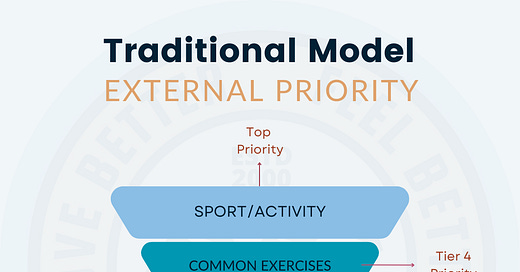An Internal Strength Model Approach To Shoulder Mobility Training
Learn how to organize training to prioritize and optimize your joint health and movement
Taking an internal approach to training not only will change the way you approach your training, but it will change the outcomes of your training over the long run. If longevity is our goal, then shifting our priorities is key to improving long term outcomes.
The Traditional Strength Model
The traditional method of strength training often relies on traditional exercises that have been created with an objective of building muscle tissue. The priority is muscle tissue and usually for most people it’s aesthetics.
This traditional model as a pyramid would prioritize the things we want to do at the bottom base, taking up the majority of our time and energies. This is the way we’ve always done things. We bench press, deadlift and squat. We play our sport and do all the activities we like, but we see the other elements of our training like, recovery, mobility training and aerobic work as filler as opposed to meat.
If we were to make up a diagram of our Traditional Model, it might look like the one below or some iteration of this:
The Internal Strength Model
Approaching training from an internal perspective shifts the priorities of the training. It moves the training outcomes away from the external world and things like aesthetics and it prioritizes the functionality of your body.
Before going any further, I’m not saying that we shouldn’t seek external outcomes, personal bests and records. What I am saying is that there’s a reason why many athletes often have a limited shelf life and longevity of their careers and post career body is short. There are a few athletes now that have slightly shifted their approach along with their trainers as they seek not only longevity in their sport, but longevity in their post sports life.




